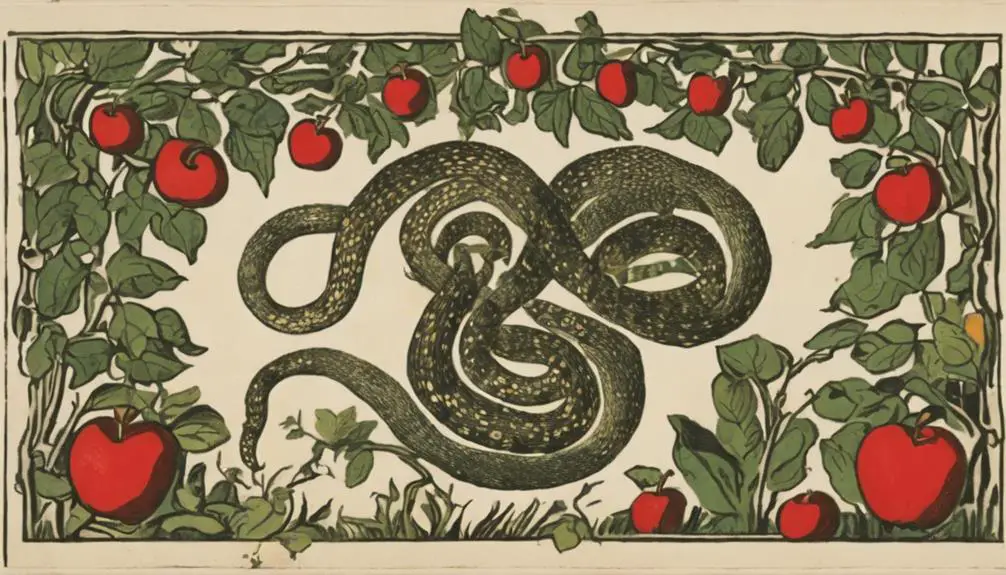Dive into the intriguing symbolism of the adder in the Bible, entwining danger, deceit, and layers of unexpected depth.

Adder in the Bible
Have you ever wondered about the significance of the adder in biblical literature?
The adder, a venomous snake, appears in various parts of the Bible and carries a weighty symbolism. It's frequently associated with deceit, danger, and sin, but there's a lot more depth to its representation.
As you explore its presence in different scriptures, you'll uncover layers of meaning that may surprise you and deepen your understanding of Biblical themes.
The adder's role is not as straightforward as it seems, which adds a fascinating complexity to its biblical interpretation.
Key Takeaways
- The adder, a venomous snake in biblical texts, symbolizes deceit, danger, and sin.
- Its representation differs from the serpent's role in the Original Sin narrative, adding layers to biblical symbolism.
- As a metaphor in Psalms, the adder signifies obstinacy of sin and the destructive effects of untruthfulness.
- The adder's dual significance, both literal and metaphorical, enhances understanding of biblical narratives and teachings.
Biblical References to the Adder

In the Bible, the adder is mentioned several times, providing a symbolic representation that carries profound theological implications. You'll find this venomous creature woven into narratives and parables, often embodying treachery, deceit, and danger.
Analyzing the adder's appearance, it's not difficult to discern why it's used in such a menacing context. Its slender, elongated body, coupled with its striking coloration and hypnotic gaze, makes it a perfect symbol of cunning and stealth, attributes often associated with Biblical serpents. Additionally, its highly venomous bite, which can bring death or severe illness, further enhances its symbolic potency.
The adder's physical characteristics aren't its only noteworthy attributes. In the Scriptures, it's often depicted as a creature of subterfuge, with a penchant for lurking in the shadows or hiding in the grass, ready to strike at the unsuspecting. This behavior mirrors the biblical narratives where serpents often represent hidden threats, unseen dangers, and the potential for sudden, unexpected harm.
Thus, the adder's appearance and behavioral traits have made it a potent and enduring symbol in Biblical literature. Its representation continues to resonate, offering a vivid illustration of the perils of deceit and treachery.
Interpreting the Adder's Symbolism

Deciphering the symbolism of the adder in biblical text requires a deep understanding of its attributes and the theological subtext it's often associated with. The adder's spiritual meaning, in this context, is multi-faceted and layered, demanding a careful, nuanced interpretation.
As you delve into the symbolic serpent interpretation, you'll find that the adder has been presented as both a figure of wisdom and caution. It's seen as wise due to its discerning nature; it carefully chooses when to strike, signifying a need for thoughtfulness and discretion. Simultaneously, its presence often serves as a warning of impending danger or deceit, a testament to its lethal venom.
However, it's critical to distinguish this symbolism from the serpent's role in the narrative of Original Sin. Although both carry intricate symbolism, they convey separate theological messages.
The adder's symbolism, therefore, is a complex blend of wisdom, caution, and potential danger. It nudges you to tread carefully, to be discerning and vigilant. By understanding this, you gain a more profound comprehension of the biblical text, unlocking layers of meaning that deepen your spiritual journey.
The Adder and Original Sin

While the adder's biblical symbolism offers lessons in wisdom and caution, it's crucial to explore its distinct role in the narrative of Original Sin, where its implications take on a different theological dimension. In this context, the adder represents the Sinful Serpent, a central figure in the story of mankind's fall from grace. The Adder's Influence, as the agent of temptation, marks the initiation of sin into the world.
Let's consider a brief analytical table:
Biblical Reference |
Adder's Role |
|---|---|
Genesis 3:1-5 |
The adder, as the Sinful Serpent, tempts Eve to eat the forbidden fruit, thus committing the first sin. |
Romans 5:12 |
Paul connects the Adder's Influence to the spread of sin, leading to death for all humans. |
This interpretation underscores the adder's complex symbolism. It is not only a cautionary symbol but also a representation of temptation and sin's introduction into the world. This dualistic perception of the adder has impacted its portrayal throughout biblical and theological discourse, presenting a nuanced, multifaceted understanding of its role and significance within the biblical canon.
Adder as a Metaphor in Psalms

Beyond its role in the narrative of Original Sin, you'll also encounter the adder's metaphorical symbolism within the Psalms, where it serves as a potent symbol of deceit and danger. This Adder's Metaphorical Transformation represents a subtle shift in the biblical perspective, where the adder emerges as a powerful figurative device.
The Psalms' Poetic Usage of the adder is particularly noteworthy in Psalm 58:4-5. Here, the wicked are likened to the adder that 'stops its ear, which won't heed the voice of charmers, charming ever so skillfully.' This metaphorical usage paints a vivid image of sin's obstinacy, mirroring the adder's refusal to be swayed by the charmer's tune.
Similarly, the adder's deadly venom is metaphorically employed to signify the destructive effects of untruthfulness and evil. The Psalmist warns of the 'poison of asps (another term for adders) under their lips' (Psalm 140:3), illustrating the peril of deceitful speech.
Therefore, in the Psalms, the adder isn't merely a creature of literal menace. It undergoes a metaphorical transformation, embodying deceit, obstinacy, and danger, thereby enhancing the depth of the poetic discourse.
Understanding Adder's Dual Significance

In grasping the dual significance of the adder in the Bible, you'll uncover a fascinating interplay of literal and metaphorical interpretations that profoundly enrich biblical narratives and teachings. This duality stems from the adder's physical characteristics and its symbolic representation.
Firstly, let's discuss the adder's venom significance. The venom of an adder, known for its deadly potency, is referenced literally in the Bible, often linked to deceit and the destructive power of sin. For instance, in Psalms 140:3, the Psalmist compares the tongues of wicked men to the venom of adders. This literal usage underscores the lethal consequences of spiritual decay and unrighteousness.
Secondly, the adder serves as a metaphorical device, enabling a broader biblical creatures comparison. The serpent figures prominently in the Bible, from the serpent that tempts Eve in Genesis to the fiery serpents in Numbers. Here, the adder, as a type of serpent, symbolizes cunning, temptation, and spiritual danger.
Therefore, the adder's dual significance in the Bible, both as a literal creature and a metaphorical symbol, underscores its complex and multifaceted role in biblical narratives and teachings.
Frequently Asked Questions
How Does the Cultural Context of the Time Influence the Depiction of the Adder in the Bible?
You're examining how cultural context shapes symbolism and interpretation.
In ancient times, an adder's symbolism could be influenced by prevalent beliefs and perceptions.
If a society saw adders as dangerous, their Biblical depiction might reflect this fear.
Conversely, if they were respected, their portrayal might be more positive.
Understanding these cultural nuances, you can gain deeper insights into Biblical interpretations.
Are There Any Other Animals in the Bible That Have a Similar Significance as the Adder?
Yes, there are other animals in the Bible with similar significance as the adder. For instance, the serpent often symbolizes deceit, while the lamb frequently represents innocence.
These Biblical zoology insights show a rich tapestry of symbolism woven throughout the text. Your exploration of adder symbolism has likely opened your eyes to these patterns, shedding new light on the ancient text and its complex, multifaceted depictions of the natural world.
Does the Adder Hold the Same Symbolic Meaning in Other Religious Texts as Well?
You're asking if the adder's symbolism extends to other religious texts, such as the Quran.
In comparative mythology studies, it's important to note that each religion has its own unique symbols.
The adder's presence in the Quran isn't as prevalent, and its meaning may differ.
It's vital to delve into the context and interpretative traditions of each text to fully understand the symbolic significance of the adder.
What Is the Historical Background of the Adder's Presence in Biblical Times?
You're delving into the historical backdrop of the adder's metaphorical role.
In Biblical times, the adder was a symbolic serpent, often associated with evil, treachery, and danger. Rooted in ancient folklore and stories, it's become a potent symbol in religious texts.
The adder's presence in these contexts doesn't necessarily mean it held the same significance elsewhere. Each culture, each text, imbues its own unique meaning onto this creature.
How Has the Interpretation of the Adder in the Bible Changed Over Time Amongst Different Christian Denominations?
Considering the shift in interpretations of biblical serpents among different Christian denominations, you'll find the adder's symbolism varies greatly. Originally seen as a representation of evil, its meaning has evolved for some groups to symbolize wisdom or even change.
It's fascinating to observe how religious perspectives can transform over time, isn't it? This demonstrates the dynamic nature of religious interpretation and its ability to adapt alongside societal changes.
Conclusion
You've journeyed through the biblical narrative, uncovering the adder's multifaceted role. From symbolizing original sin to serving as a metaphor in Psalms, the adder's dual significance is undeniable.
It's a testament to the layered richness of biblical text and its enduring relevance. As you continue exploring biblical symbols, remember the adder's intriguing duality – a reminder of humanity's capacity for both sin and redemption.



Sign up